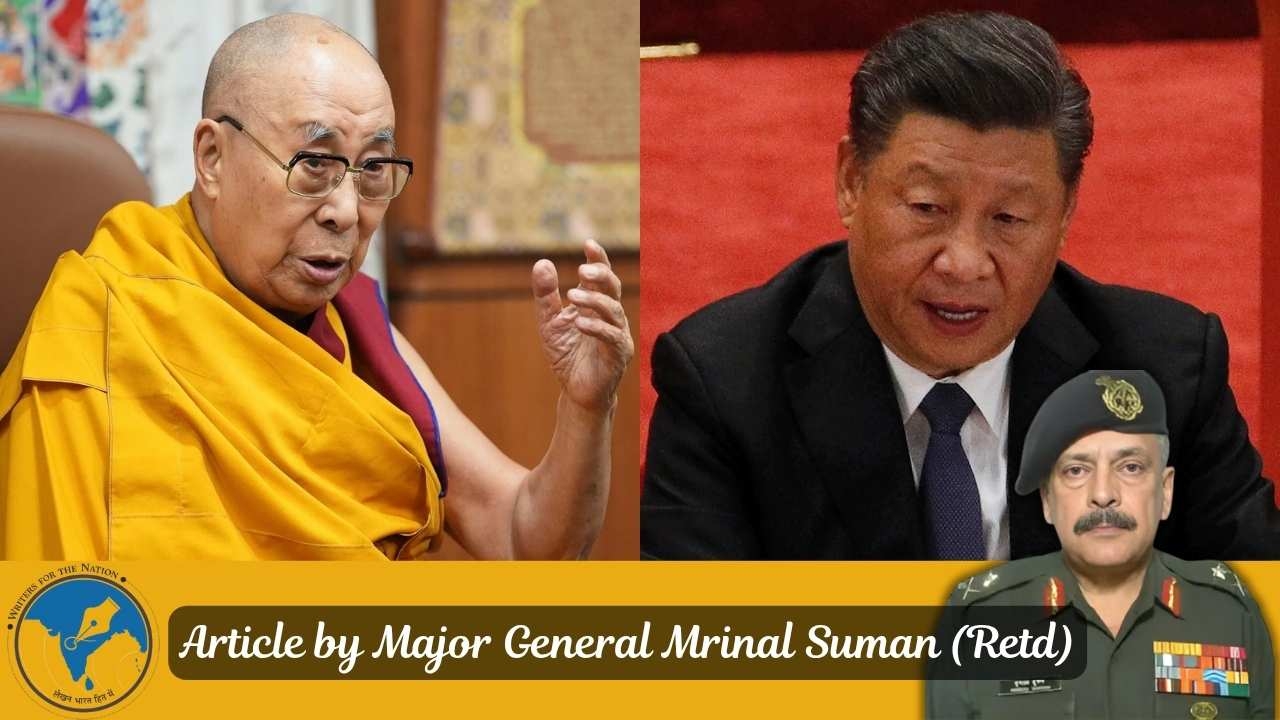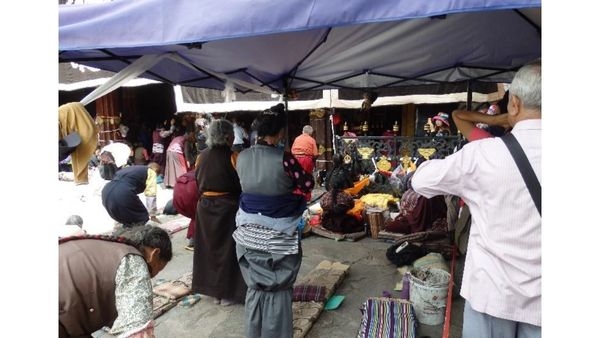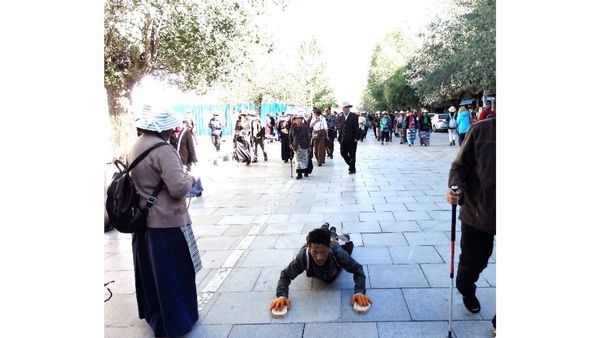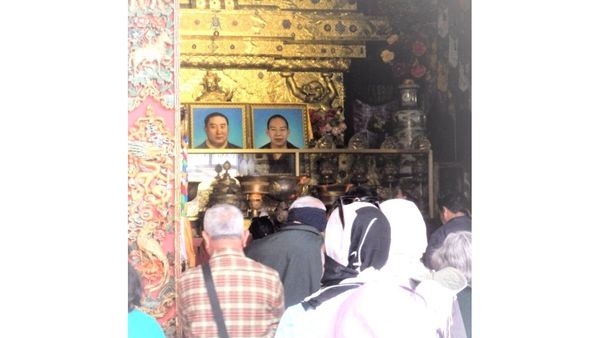China’s Achilles’ Heel: The Dalai Lama
08 Jul 2025 11:58:22

My two visits to Tibet in the recent past, spanning across the plateau from Kailash-Mansarovar and Shigatse in the west to Lhasa in central Tibet and Nyingchi in the southeast, were a revelation. One always knew that the Dalai Lama enjoyed a huge following in Tibet. However, one has to spend time in Tibet to truly appreciate the intensity of devotion and reverence in which he is held by his devotees.
On 05 Jul 25, the Dalai Lama turned 90. Expectedly, the question of selecting his successor acquired urgency. Earlier, in a statement issued on 21 May 2025, the Dalai Lama had reaffirmed that the next Dalai Lama would be chosen after his death by the Gaden Phodrang Trust, the Office of His Holiness the Dalai Lama. More significantly, he had warned that ‘no one else has any authority to interfere in this matter’. However, Beijing continues to claim that the next incarnation will be in China and will be subject to its approval.
Norman Cousins considers history to be a vast early warning system. Unfortunately, former Indian leadership had been displaying a distinct disdain for history. Resultantly, India failed to learn lessons from history and be forewarned.
Every student of Chinese history knows that a strong China has always been an expansionist China. Coercion and intimidation are well-tried instruments of China’s state policy. It has never lived in peace with its neighbours.
Ad-hocism has no place in the Chinese scheme of things. All wings of the Chinese government work in tandem and in complete harmony. There are no isolated initiatives. Chumar, Doklam and Galwan intrusions were not localised incidents. They are a part of their long-term and well-thought-through plans.
Hostility and disdain towards weaker opponents are in the Chinese DNA. It respects strength. Diplomatic niceties and good neighbourly relations mean little to it. Unfortunately, acquiescent India has convinced the Chinese of its timidity to stand up to coercion.
In 2008, India’s envoy to Beijing was called by the Chinese government in the middle of the night for frivolous reasons. The ambassador promptly reported to the Chinese foreign ministry without a whimper of protest. Whereas even a banana republic would have taken offence and chided the ambassador for abject servility, India promoted her to the coveted post of the foreign secretary.
Chunar incursion is symptomatic of India’s inexplicable reticence towards China. In order to improve its ground deployment, India constructed a few bunkers and semi-permanent structures at Chumar and other places, all well within its own territory. In protest, China intruded 19 miles deep inside the Indian area and established a tented camp as a bargaining leverage. The Indian leadership got unnerved. Overruling the army’s objections, it ordered it to accept the Chinese terms. Having achieved their aim, the Chinese withdrew. Indian capitulation would have certainly emboldened China.
Time to Stand up to the Bully
The Chinese army is a formidable force. Being an authoritarian communist state, China diverts enormous resources to its armed forces to achieve its global ambitions. On the other hand, democratic India apportions maximum resources for improving the quality of life of its citizens. Thus, there is a huge gap between the defence budgets of the two countries. In addition, the Tibetan plateau favours China immensely, both for rapid mobilisation of forces and their maintenance. India, on the other hand, has to cross the mighty Himalayas to induct troops. Logistic challenges assume nightmarish proportions, especially during the winter months.
Although India can ill afford to get into an arms race, it must acquire the necessary military deterrent power to inflict unacceptable damage on an antagonistic China.

More importantly, in the modern era, wars are not limited to armed conflicts alone but span the complete gamut of geo-strategic, diplomatic and commercial imperatives. There are many prudent and cost-effective alternatives that can be effectively exploited to counter Chinese belligerence and inflict severe damage to its national interests.
As regards the commercial field, India has already shown rare mettle in taking many major steps to hurt the Chinese economy. In the geostrategic space, India is collaborating with other friendly nations to build international opinion against China’s expansionism.
However, it is time to be prepared to hurt China where it hurts the most, i.e., national psyche. National psyche symbolises those emotional and intellectual vulnerabilities that are embedded in the mental obsessions of a nation and trigger violent upheaval when threatened. China is no exception. It considers Hong Kong, Taiwan, the South China Sea, Uighur camps and Tibet to be the core issues that are essential for its survival. Every reference to them is taken as a direct threat to its identity.
Although China annexed Tibet in 1950, it has singularly failed to crush the Tibetan spirit and obliterate its ancient identity. While estimates vary considerably, it is believed that up to one million Tibetan people have been killed by the Chinese to suppress their demand for freedom. Such grave atrocities committed through political and religious repression have further strengthened the resolve of the Tibetans for independence.
Tibet is China’s Achilles’ heel. The Dalai Lama is a lethal dagger in the Chinese heart, which can be twisted by India with devastating effect. China considers the Dalai Lama to be the biggest impediment to the integration of Tibet with mainland China, as he epitomises the hopes of millions of Tibetans. In fact, he has become a symbol of Tibet’s struggle for independence.
Frustrated with its failure to stamp out the Dalai Lama’s sway over the locals, China has been trying its best to obliterate all signs of his existence. The very mention of his name makes the Chinese extremely nervous and apprehensive. Therefore, India must not lose this advantage through neglect or oversight.
Chinese Paranoia of the Dalai Lama
For the Buddhists, the Dalai Lama continues to be the supreme spiritual head and the living god. They hold him in great esteem and visit the Potala Palace in throngs to pay their respects to the exiled leader and pray for his long life. Many devotees cover long distances by lying prostrate at every step.

A visit to Norbulingka, the summer palace of the Dalai Lama, can be an overwhelming experience. As no picture of the Dalai Lama is allowed to be displayed in Tibet, the locals prostrate before his relics in reverence. Impoverished Tibetans in tattered clothes offer a part of their meagre earnings at the altar. They bring home-made butter to keep the lamps lit, in the hope of his early return to free Tibet.
Tibetans are not issued passports and hence cannot visit other countries. Many young Tibetans, including those born after the exile of the Dalai Lama, rue the fact that they cannot visit India to pay respects to His Holiness. When told that we were from India, a young hotel boy, with moist eyes, told us that his sole ambition in life was to visit India to bow before His Holiness.
Although the Tibetans are wary of expressing their views openly, they never fail to express their gratitude to India for giving asylum to their temporal head and millions of other Tibetan refugees. A middle-aged woman vendor put a handful of walnuts in my hand, as if to say ‘thank you’.

Despite the most ruthless holocaust, China has failed to undermine the standing of the Dalai Lama. No wonder that the Chinese paranoia of the Dalai Lama goes to ridiculous extremes. No paper, document, newspaper, photograph or other material concerning the Dalai Lama can be carried into Tibet. Visitors are asked to get down from their bus with complete baggage. Each and every bag is required to be opened and all contents laid out on the roadside for inspection by the police. Even cameras and mobiles are checked for stored pictures.
A policeman accompanies every tourist bus to ensure that the allowed itinerary is strictly followed. In addition, he makes certain that the visitors establish minimum contact with the locals, lest they reveal the true state of affairs. The bus has to periodically report to the designated police stations for security clearance to proceed further.

The Dalai Lama cannot be referred to as His Holiness. If overheard by the all-pervading police, a stint in prison is assured. No monastery can display his photo, whereas those of the lackey Panchen Lama can be commonly seen. Algorithms of Chinese social media apps block all reference to independent Tibet and the Dalai Lama.
China’s Wait-out Policy
Having failed to win over the 80-year-old Dalai Lama, China is waiting for his demise to install a pro-China boy as the next Dalai Lama. It wants to replicate its successful subterfuge that it executed earlier in the case of the Panchen Lama.
Traditionally, the Panchen Lama is considered second to the Dalai Lama in hierarchy. After the escape of the current Dalai Lama to India in 1959, Panchen Lama Choekyi Gyaltsen sided with communist China. However, by 1962, he was a disillusioned man and accused China of smothering Tibetan culture. He was imprisoned in 1964 and subsequently kept under house arrest. He died suddenly under mysterious circumstances at Shigatse in 1989, when he was only 51 years old. Locals are convinced that he was poisoned by the Chinese.
A boy named Gedhun Choekyi Nyima was chosen to be the next Panchen Lama by the Dalai Lama and the then-incumbent abbot of Shigatse’s Tashilhunpo Monastery. However, the boy went missing soon after his nomination and is untraced to date. It is alleged that he is still being held in captivity at an unknown location in China.
In his place, the Chinese government conspired to select Gyaincain Norbu (son of two Communist Party members) as the 11th Panchen Lama. Most Tibetans do not recognise Norbu as the Panchen Lama and consider him to be a stooge of the Chinese.
It is feared that China may adopt a similar stratagem after the demise of the current Dalai Lama. In fact, it has already started manoeuvring itself to be in a position to have its say. Support of the lackey Panchen Lama will help China considerably. If the followers of the present Dalai Lama select a boy living in Tibet, he will be eliminated by China and replaced by a loyalist boy. Thereafter, with the support of a pliable Dalai Lama, China hopes to tighten its grip over the religious and spiritual facets of the Tibetan culture.
India Must Act Now
In 2011, China openly claimed that the right to appoint the next Dalai Lama rests solely with it. It also warned that no other succession candidate would be recognised. Hence, China’s devious stratagem is no secret.
Therefore, India must act fast. His Holiness the Dalai Lama celebrated his 87th birthday in July 2022. He is aware of the Chinese ploy. Being an erudite, far-sighted and progressive spiritual leader, he knows that he is the sole hope of millions of Tibetans who are dreaming of an independent country. He is aware that if a Chinese pawn becomes the next Dalai Lama, Tibetan culture and the country will be lost forever.
Traditionally, the search for the successor to the Dalai Lama starts soon after his death. Spiritual signs and visions that indicate the likely place of his rebirth are interpreted by learnt monastic scholars. Thereafter, vigorous efforts are put in to locate the child. Once identified, he is put through a number of tests before his final anointment.
Earlier, he had toyed with the idea of appointing his reincarnation during his lifetime and transferring his spiritual realisation to the successor in person. However, in a recent statement, he declared that his reincarnation should be chosen after his death by the Gaden Phodrang Trust, the Office of His Holiness the Dalai Lama. That may be too late.
As time is running out, immediate action needs to be initiated. Monastic scholars from Hemis Monastery, Ladakh; Tawang Monastery, Arunachal Pradesh; Rumtek Monastery, Sikkim; Thiksey Monastery, Ladakh; Namdroling Monastery, Karnataka; and Mindrolling Monastery, Dehradun should be urged to convince the Dalai Lama to allow the selection of his successor immediately. Once blessed by the Dalai Lama, the chosen child should be brought to Dharamshala for religious education and spiritual initiation. Such a move will preempt all devious Chinese designs.
China should not be allowed to repeat the farce that was perpetuated in the selection of the Panchen Lama. It will be catastrophic for the aspirations of millions of Tibetans who want to see an independent Tibet with the Dalai Lama in the Potala Palace at Lhasa.
The Dalai Lama is a lethal arrow in India’s quiver that can be used against hostile China with devastating effect. India should never lose this unique ace up its sleeve. India’s advantage will be lost irredeemably if China is allowed an opportunity to nominate its crony as the next Dalai Lama. History is most unforgiving. Mistakes once made cannot be undone. Therefore, India must act urgently and prudently.
Article by

Major General Mrinal Suman (Retd)
AVSM, VSM, PhD, commanded an Engineer Regiment in the Siachen-Kargil sector. He was also the Task Force Commander at Pokhran and was responsible for designing and sinking shafts for the nuclear tests of May 1998. He is a highly qualified officer – B Tech, MA (Pub Adm), MSc (Def Studies) and Doctorate in Public Administration. He is a prolific writer having published nine books and over 550 articles.